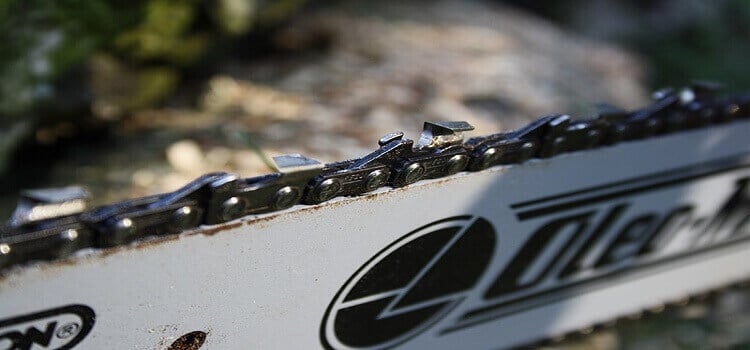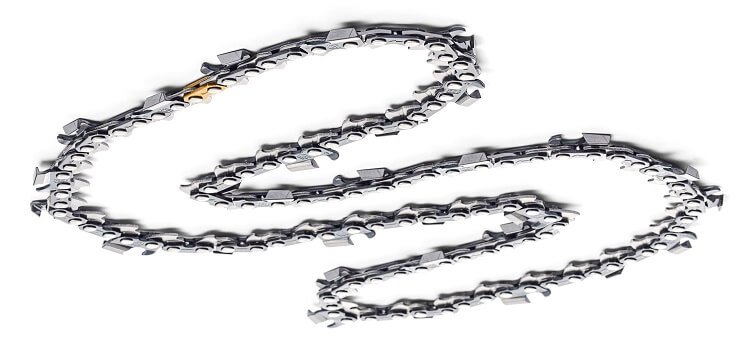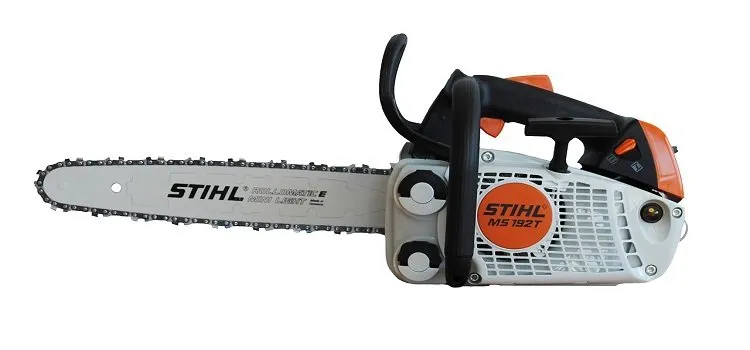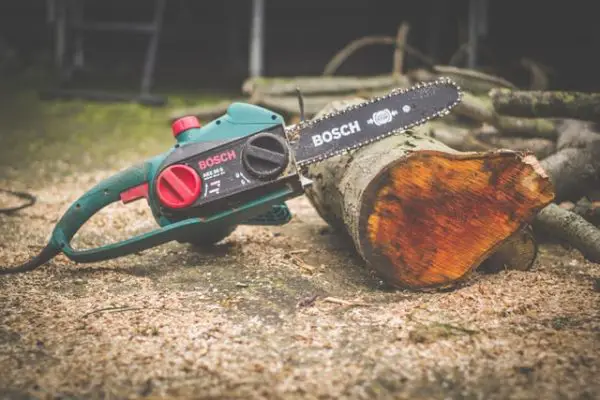Whether it is cutting trees, shaping logs, or building a piece of furniture, the chainsaw is a must-have tool. It doesn’t matter how many times you use it, as it comes to the rule of nature, sooner or later, a chainsaw’s chain is bound to get worn out.
The question is, ‘how to tell when a chainsaw chain is worn out?’
This is very important because a worn-out chainsaw chain can not only hamper your work and put a strain upon the machine; it also can cause you to suffer from serious accidents. You should have a clear perception of the issue to notice the signs before something significant occurs.

Don’t worry; we are here to help you. This guide will help you understand everything when it comes to a worn-out chainsaw chain needing replacement.
Chainsaw Chain
 As our discussion topic is chainsaw chain, why don’t we refresh our idea regarding it? Generally, we deal with two kinds of chainsaws; electric chainsaw and gas chainsaw for commercial and home use.
As our discussion topic is chainsaw chain, why don’t we refresh our idea regarding it? Generally, we deal with two kinds of chainsaws; electric chainsaw and gas chainsaw for commercial and home use.
As we all know, one of the primary components of any chainsaw is the chain. The chain is made of multiple steel links joined by rivets. Its inside has flat drive links to connect the chain on the saw’s bar, while its outside has razor-sharp cutting teeth.
When you power the chainsaw on, the teeth generate a cutting force enough to cut down big trees. Such a marvelous invention!
And that is why making sure that your chainsaw chain is in tip-top shape is so important. One of the most common chainsaw related injuries is caused due to saw kickbacks. And the probability of chainsaw kickbacks increases when you have a faulty chain.
So, better be careful and ensure you have a good chain to reduce the risk of accidents.
How to Tell When a Chainsaw Chain Is Worn Out
And how will you be able to reduce the risk of injury and accidents? By determining the signs of a worn-out chainsaw chain and replacing it as fast as possible, of course!
But to do that, you will first need to know how to figure those out. So, keep your eyes open to notice the following signs as early as possible, okay?
It is hard to position your chainsaw
How will you know your chainsaw is in tip-top condition? Well, when you will have an excellent, stable, unshaken chainsaw while set against a piece of wood. Because a super sharp chainsaw encounters less resistance against the hard surfaces.
But whenever you experience a bouncing or rattling sensation, you’ll need to understand that your chain has passed its hay day. It’s time to get a new one as soon as possible.
The chainsaw fails to pull itself into the wood
Using a chainsaw doesn’t require physical force. All you’ll need to do is not to operate it with a steady hand, it will automatically pull itself into the wood and keep cutting. At least that’s what a right chainsaw is supposed to be doing.
But it won’t happen with the damaged chain. In that regard, you will have to apply manual force to keep it stable and in the right direction. In such cases, you better get a new chain.
Smoking while cutting wood
Another indicator of a worn-out chain is smoking during an operation. The device will generally produce smoke when it is lubricated insufficiently or the chain tension is incorrect. In such cases, lubricating it properly and adjusting the chain tension can fix the issue.
But what if, despite taking these measures, the smoking issue is continuous? That means your chain is not in good health and needs either sharpening or a replacement.
There are issues with your chain tension
Speaking about chainsaw tension, do your chainsaw chain get easily loosen and needs frequent adjustments? Yes, your guess precisely right. Your chain is worn out, and you need to get a new one as fast as you can.
Don’t be stingy. Many chainsaw related injuries are caused due to a loose chain. Get a replacement immediately.
Jagged and crooked cuts
When you use your chainsaw to make a crosscut or a vertical cut, if the saw cuts through the wood in a straight, precise line, that means your chainsaw chain is in good shape. And when it goes unusable and reaches its life span’s end, the result will be the exact opposite.
At this point, you will have a hard time making a straight line and maintaining precision. Rather than being straight lines, the cuts will become crooked and jagged. This sign indicates that the chainsaw blades are getting dull.
In some cases, sharpening the blades is all it takes to get it into shape. But there still are some limits to using this method.
You can adopt this strategy if your chain is recently bought and used a few times. But after a specific time of operations, it is best if you switch to a new one.
It produces sawdust while cutting
A sharp, proper-conditioned chainsaw produces sharp wood chips when it cuts through wood. But when the chain’s teeth get dull, they tend to grind more and produce fine sawdust.
You can resharpen them, of course. But that is not the ultimate solution. Resharpening can work for a long time indeed, but gradually the need for applying more force increases.
In the end, a time will come when the depth gauge can no longer be filed. Sharpening will no longer work here. That is the time when you should get a new chainsaw chain.
Damaged or missing teeth
We suggest you check out the teeth of your chainsaw every once in a while, especially during sharpening. Are there any signs of damages, such as broken or off-center teeth? Then there is bad news for you, and it’s time to get a new chain.
And sorry to say to you, sharpening is no longer the remedy here. Like the missing teeth is the sign of a person’s old age, and thus the natural life span’s end, here the damaged or missing teeth represents a chainsaw chain’s life span’s end. This is the most important sign that your chainsaw chain is worn out.
Chainsaw Chain: How Long Does It Last?
As you have noticed, a chainsaw chain can be resharpened and used for a long time. Many of the signs mentioned above match the signs of a dull chainsaw chain, and sharpening can fix that.
Still, there are limits to how long this strategy can work. You can sharpen for at least five times before your chainsaw chain needs a replacement, but that mainly depends on your usage.
And believe us, the life span of your chainsaw chain depends on you, and there is no fixed time.
Typically if you are a frequent user, a chainsaw chain can last for more than five years. If you are not, it can last for decades. Ultimately it all comes down to how you use and care for it.
Factors Causing a Faster Chainsaw Wear
If you want your chainsaw chain to last for a long time, you should take heed of some factors and try to avoid those factors if possible.
- The harder your wood, the faster your chain will wear down. So, as you can guess, using a chainsaw to cut softwood will help it last longer, while the exact opposite will happen for hardwood applications.
- The chain-type matters as well. Try to use a semi-chisel chain instead of a full-chisel chain, as the first one usually lasts longer.
- Cleanliness is also important. Take care not to cut dirty wood or touch the ground with the blade. The accumulated dirt and dust will make your chainsaw chain rust and wear faster.
- The longer you cut, the faster the chain wears and tears.
- Never put a steep angle on the cutters. It will put excessive pressure on the blade.
- Be careful while sharpening. Don’t use just any sharpener when it comes to a chainsaw blade. Always use the right file size, and if possible, around sharpening stone.
- And, of course, proper maintenance is a must. Always apply appropriate lubrication and keep the chain well-lubricated. The more friction, the faster the wear.
Ending Remarks
As you can see from the article, in the end, the life span of your chainsaw chain depends on how you use and care for it. But even if you put your all in it, a day will come when you will have to say your old chainsaw goodbye.
What is important is that you understand how to tell a chainsaw chain is worn out before any major accidents happen. We have noted down the details in this article for you.
The rest depends on your observation capacity. When the time comes, don’t be stingy, and get a new one as fast as possible.


